PPC Management for Small Businesses: Key Tips & Strategies
It’s frustrating to spend all your current marketing budget on ad campaigns and see little to no results. You’d feel like you’ve wasted time on keyword research, account setups, bid optimization, and other core tactics that make your ad campaign potentially successful.
But before you cross out PPC from your marketing strategies, I’ve distilled eight (8) different PPC management strategies to help you maximize your ad spend and see tangible ROI.
8 PPC Ad Management Tactics for Small Business
First, you should’ve created a Google Business Profile to organically increase the visibility of your business in your local area. If you don’t, read this article to learn how to optimize your business profile to rank on Google map pack. If you offer a service business, read this article to know how to rank your business without a physical location.
With that out of the way, here are 8 PPC management tactics that have helped us with some of our clients:
1. Use Localized Geo-targeting:
Localized geo-targeting is like filtering out other locations to focus on a specific location to amplify your reach to desired locations.
In PPC advertising, this strategy allows you to customize your ads to a specific location— a city, state, region, or country. You can even narrow it down to a zip code or a 20-mile radius from your store.
This strategy is best if your small business relies on in-foot traffic (say, cafes, restaurants, and motels or an online business that makes local deliveries to neighboring towns and cities).
Why is this effective?
- 80% of Google searchers use keywords with local intent
- Another 76% of users who conduct local searches visit the business within a day
- 46% of all Google searches have a local intent
- Searches with the “shopping near me” phrase have increased by 100% YoY (year over year)
[Source]
All these mean that you can focus your PPC ad spend on areas that attract more visitors than others. You’ve been in business for a while, and according to your traffic sources, you know where most of your audience comes from. Target these locations.
Also, customers are more likely to click your ad when they see personalized ad copy from the results page.
What to do:
Start with your data. If you’ve run PPC ads before reading this article, check the location(s) where you have the highest conversions.
You can also analyze your website traffic on Google Analytics to see where many visitors come from and optimize accordingly.
For example, if you run a brick-and-mortar store in Chicago, optimize your ad campaigns (and keywords) for Chicago users. After all, your primary target audience is in Chicago, and it makes absolute sense to limit your ads to this location.
Also, use negative keywords to exclude all other locations you don’t serve within your target area, including areas that aren’t converting well. I’ll share more details on this in the third point.
2. Optimize Your Ad for Exact Match, Long Tail Keywords
Exact match, long tail keywords are the phrases your (potential) customers use while searching for your products/services online.
Usually, they are less competitive, have low search volume, and have a low cost per click (CPC). For example, the CPC for “Wedding planner” is $2.14:
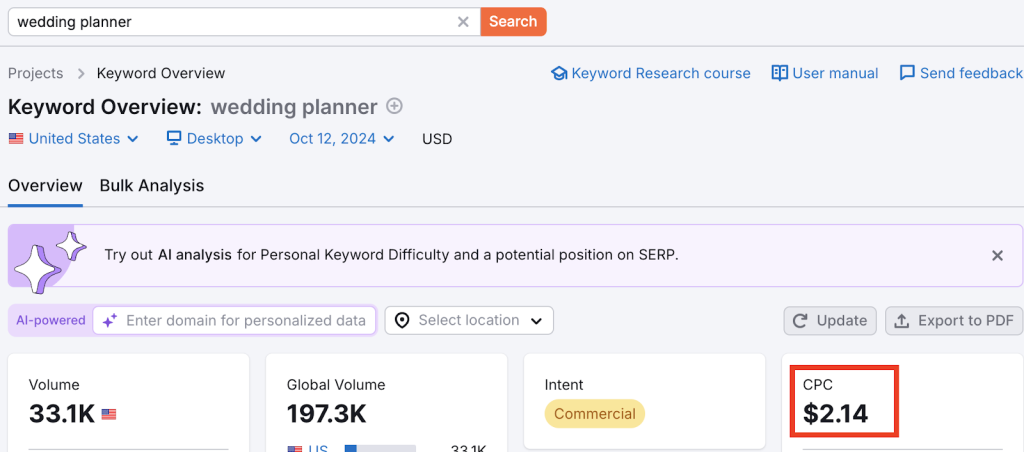
The local alternative, “Wedding Photographer in Wellington,” has a CPC of $1.74!
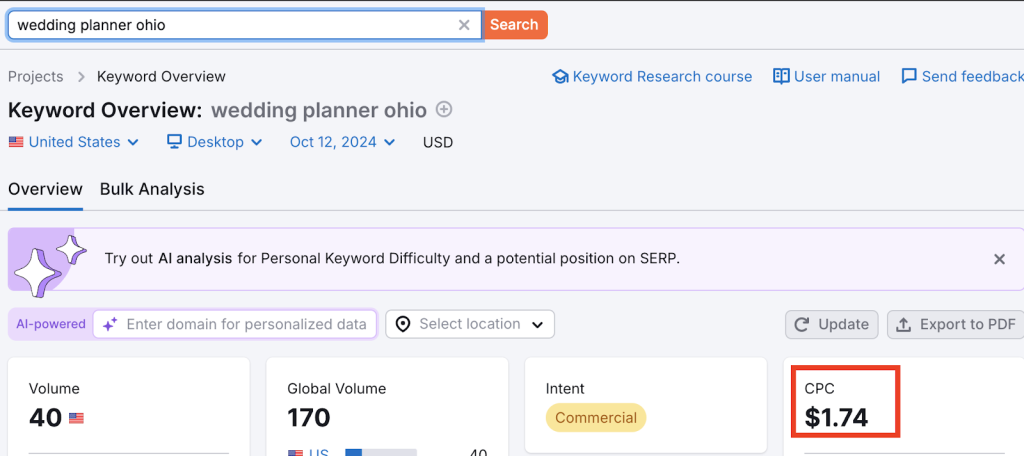
What to do:
Perform keyword research to find long tail keywords that match the exact keywords for your ad campaign. These keywords should also have high conversion intent for your specific target audience.
To improve your chances of reaching the right audience, add location modifiers such as “nearby,” “near me,” or your service areas, e.g., “plumber in Memphis,” etc.
3. Use Negative Keywords
Negative keywords are the search terms added to your ad campaign to prevent you from appearing for irrelevant search queries. You can add these keywords to your ad account, group, or campaign to avoid ranking for queries with low chances of conversion. Or queries that aren’t specific to your target market.
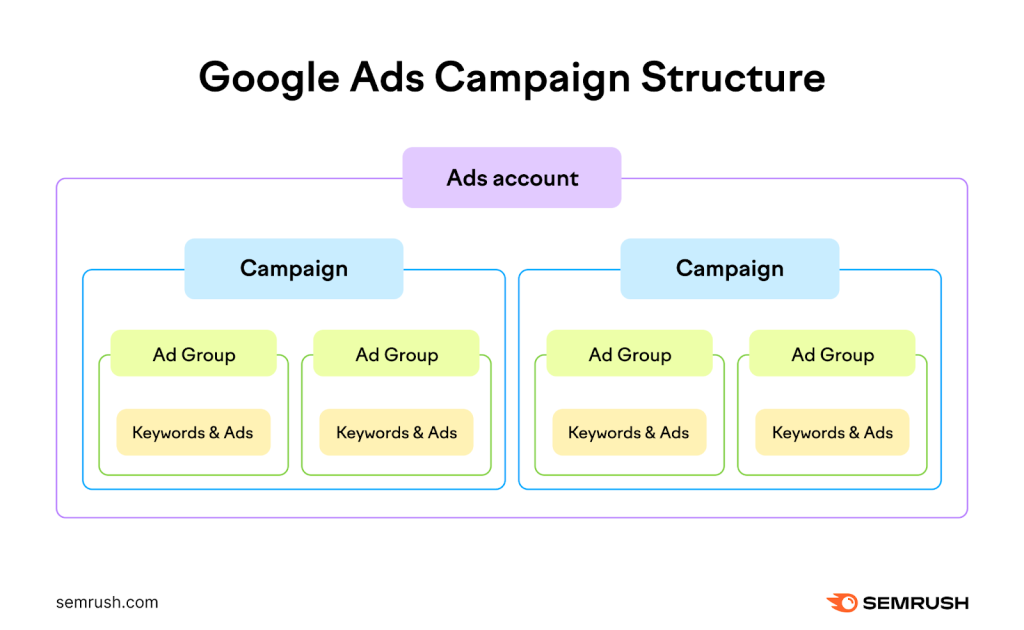
This PPC management tactic helps you maximize your ad spend and helps you appear for searches relevant to your business. See this illustration from SEMrush:
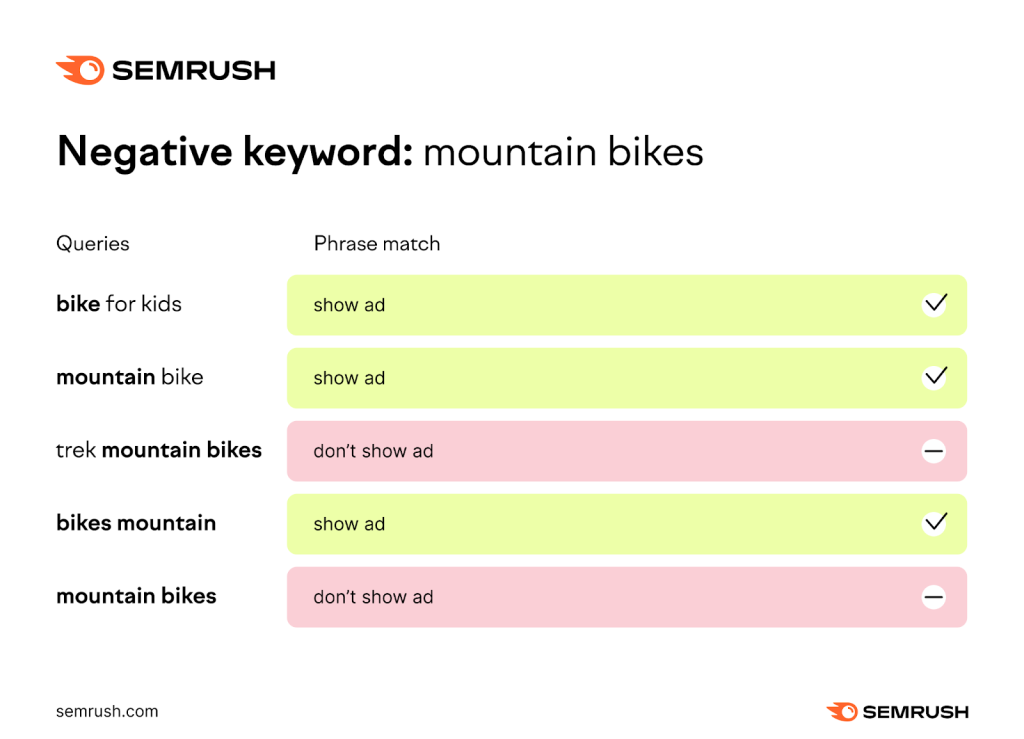
What to do:
Create a list of the search terms you don’t want to appear for. This can be products/services similar to your target keyword but not within your offerings, competitors’ names, etc. For example, if you’re selling luxury watches, exclude terms like “cheap watches,” “affordable watches,” or “free watch giveaways.”
Read more: How to add negative keywords to your PPC ad.
4. Optimize Your Landing Page to be Conversion-ready
The landing page is the first thing every visitor sees after clicking your ad. This is why it must contain relevant content reinforcing the ad copy, be navigable, and have a strong call to action to incite conversion.
If your landing page doesn’t have these, your ad campaign will fail, even if you targeted the right keywords.
What to do:
- Your PPC landing page is an extension of your ad copy. Users who click on your ad expect to see how you can help them solve their problems. Your PPC ad should communicate this straight off the bat. In a sentence, align the headline, content, call-to-action, etc., with your ad.
For context, if your ad copy is “Lose Weight with this 30-day Program,” your landing page should explain how your program will help them lose weight in 30 days, not 300 days or one year.
- Go straight to the point. Avoid unnecessary language that doesn’t address your target audience or their pain points. If you’re using a lot of text, highlight the important text in bold.
Or break sentences with bullet points. This makes it scannable and easy to read.
- The overall page experience is as important as the content. Check the technical health of the page (and the overall website). Does it load fast? Is it mobile-optimized? These are little foxes (errors) that destroy ad success.
- Use clear, conspicuous calls to action throughout the page. Each CTA should tell the users the next step to take and be positioned strategically to incite conversion.
- Structure your content logically. Although you’re trying to compel them to take an action on your page (for instance, buy a product), don’t make this the focal point. Start by elaborating on their pain points and how your product/service is the solution.
Include social proof from previous customers or add incentives to nurture them naturally to conversion.
Remember, a good landing page experience is one of Google’s factors in determining quality scores. And the higher your quality score, the lower your ad spend.
Read more: How to create a conversion-ready landing page for your PPC ads.
5. Use Ad Extensions
Ad extensions are PPC management features you can add to your ad campaigns to provide more information or improve user experience. This can be links to other pages, contact details, or structured snippets. See this example below:
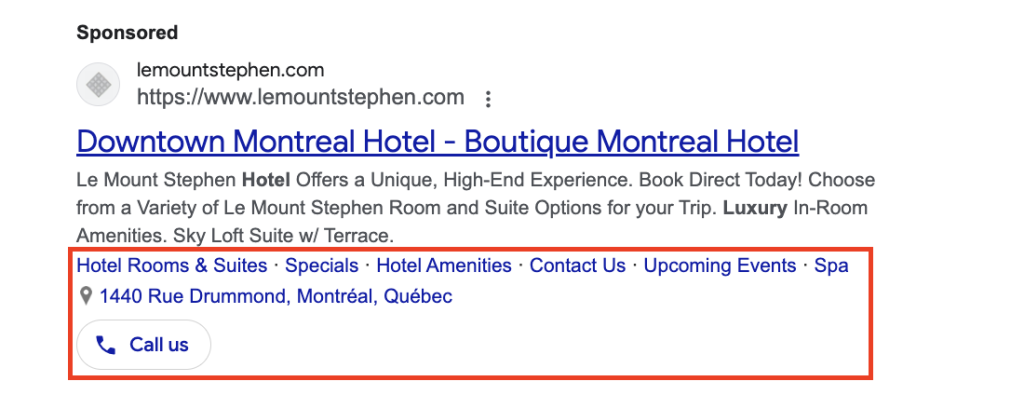
They’re (very) effective because:
- They help you share more information in a single ad. From the example above, the advertiser added the location, contact details, and site links relevant to the search query. These data would have been minimized if placed in the ad copy.
- They allow you to convert customers right away. Instead of clicking through to your landing page, users may be compelled right on the search results and choose to call or visit your business.
- They improve your ad’s quality, which means better quality scores and lower CPC.
- They’re reported to boost ad click-through rates by 10 – 15%!
Luckily, these extensions are free. You also have different options to choose from for your PPC ad.
What to do:
Explore the different types of ad extensions to choose the one(s) relevant to your conversion goal. For example, use site link extensions to direct users to the product pages to create awareness for a new product. You can also call out extensions to highlight key features like user reviews. On the flip side, if you want to increase sales, use location and call extensions to help people contact you quickly.
6. Use Retargeting
It’s rare for customers to convert on the first visit.
Their search journey usually includes several touchpoints, and it may take a while before they finally decide to buy, except they’re running branded searches.
Retargeting helps you reach this customer category and maximize your ad spend. It also helps you identify frictions in the customer journey that may prevent them from converting immediately.
For example, if a user abandons their cart midway through the purchase, it’s clear that they intend to buy but may have encountered issues such as high shopping fees, a lengthy checkout process, or even limited payment options.
In this case, use heat maps and session recording tools to find the break-off points. This will help you understand how to improve your process for seamless conversion. This is just one of many cases, but you get the idea.
What to do:
Segment your remarketing audience based on their intent, purchase history, interactions, or demographic attributes. Then, create a remarketing ad tailored to each segment to increase the chances of conversions. For example:
- Intent: This PPC management tactic covers audiences that have shown readiness to convert, e.g., cart abandonment. Use heatmaps to see why and where they dropped off and improve the conversion process. Then, run remarketing campaigns using incentives like discounts or free deliveries to incite conversion.
- Purchase history: These are people who have completed an action on your site, e.g., purchased a product or opted into your mailing list. For this set of audiences, create a list of “lookalike audiences for past purchases” and target them with upsells or new products.
- Website interactions: This category of people actively engages with your content (and even social media pages) but has yet to convert. Use social proof, user-generated content (UGC), or FOMO (fear of missing out) techniques to increase sales.
- Demographic attributes: This covers the audience within your demographic data. You can show your ads to searchers within a specific location and age group. For instance, if you own a fashion store in Memphis, TN, you can customize your ads to women between the ages of 25 and 35 in this location.
Tip: Be careful not to overwhelm your audience, as they might become fatigued quickly. Instead, use frequency capping to limit how often they see your ad. This helps you stay top of mind without becoming intrusive.
7. Focus On the Quality Score
Google’s ad auction system is determined by:
- Keyword and ad quality (quality score)
- Your ad budget
Since you have a budget limit, your next focus should be to improve your ad quality score. Let’s explore this further.
Quality score aggregates your ad quality, landing page experience, and keywords. It is rated from 1 to 10, with 1 being the lowest and 10 being the highest.
According to Google, “The more relevant your ads and landing pages are to user search queries, the higher your ad quality score.” This means to improve your ad quality score, you need to:
- Target the user intent
- Provide a visually appealing landing page experience
- Use the right keywords to increase click-through rate (CTR)
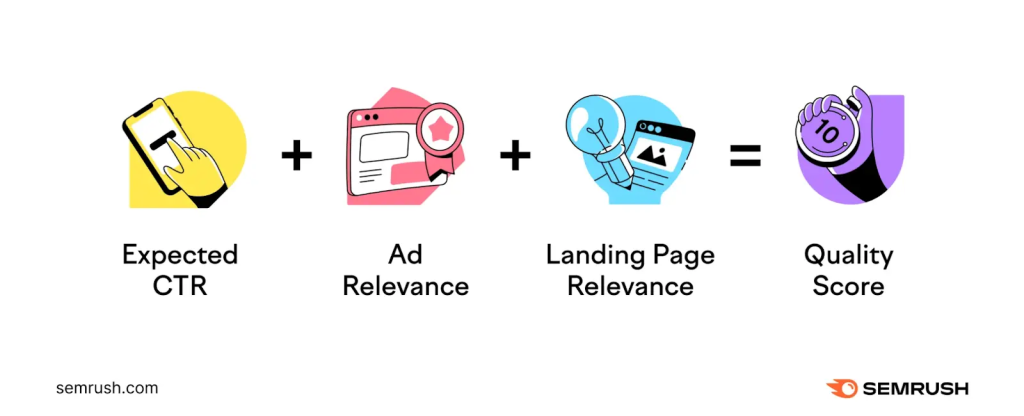
What to do:
- As I shared above, ensure your landing page is an extension of your ad. I love how Google puts it:
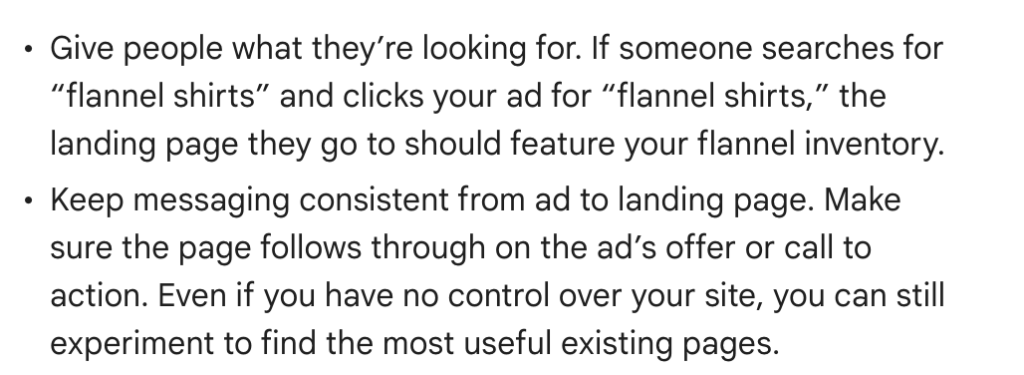
- Choose keywords based on intent. Consider long-tail keywords that are “exact or phrase match” with user search queries. Exact match keywords allow you to show up for the search queries a user searches for. Phrase match keywords are less targeted than exact match, but you’ll appear for keywords containing a specific phrase relevant to your business.
- Ensure your ad copy aligns with user search intent. It should answer, “What’s in it for me?”
- Optimize your landing page to address user pain points. It must be easy to navigate and have clear CTAs.
- Test your landing page – using A/B testing – to know which section or elements perform better.
- Organize related keywords into ad groups to increase relevance.
8. Test and Make Data-driven Iterations
The final phase of any PPC management strategy is to test everything.
Testing your ad campaigns gives you insights into what’s working, what’s not, and what needs optimization to increase conversion rates. Also, since you have a budget limit, testing your campaigns helps you better understand how to make every dollar count.
It also guides you on A/B testing initiatives that can improve the success of your ad campaign.
What to do:
- Identify and limit ad budget to pages and audience segments that are not converting.
- Review your ad schedules to know the peak search times.
- Track your campaign’s key performance indicators using the right metrics. If your goal is sales, your core focus will be conversion rate, click-through rate, and ad impression share.
- Create different variants of your ad copy and use A/B testing to find the best-performing one.
- Review ads regularly to find areas that need improvement. Delete ad groups or keywords that are underperforming.
Read more: How to run ad tests.
Conclusion – Partner with a PPC agency
Yes, PPC works for small and medium-sized businesses. Even if you don’t have large budgets to compete with enterprise businesses, you can create targeted campaigns to get higher returns on your ad spend.
If you’ve tried all the tips above but aren’t seeing the desired results, I (totally) recommend partnering with a PPC ad agency. This isn’t a sales pitch for our marketing agency, and it’s okay if you opt for another agency.
Contrary to popular opinion, working with an agency saves you more money because they know the mistakes to avoid. Working with an agency helps you to:
- Use industry expertise to get more from your ad campaigns
- Access quality marketing tools
- Spend time doing other important activities to grow your business and
- Optimize your ad budget
If you’re still thinking otherwise, here’s proof that you should consider an agency:
When one of our clients, Gaffney Group—a monument maker in Memphis—decided to run paid ads, it had issues targeting its ideal customer base. Its competitors also outperformed it on search results pages with better messaging, even though its service offerings were better.
Here’s what we did:
- Used Google’s precise targeting options to target users within Gaffney Group’s service areas (In line with point #1)
- Optimized the user conversion journey from ad clicks to conversions. We used clear CTAs on the landing page and aligned the messaging to user search intent (in line with point #4)
- Tested and adjusted their ad bids accordingly to improve targeting (in line with point #8)
- Created ad copy that emphasized their competitive advantages and customized it to match the landing page content (in line with point #4)
At the end of the campaign, they saw a:
- 88.98% increase in conversions
- 62.44% increase in engagement
You can read the full case study here. Or, speak to any of our PPC experts to review your ad accounts and recommend strategies to improve your performance.
